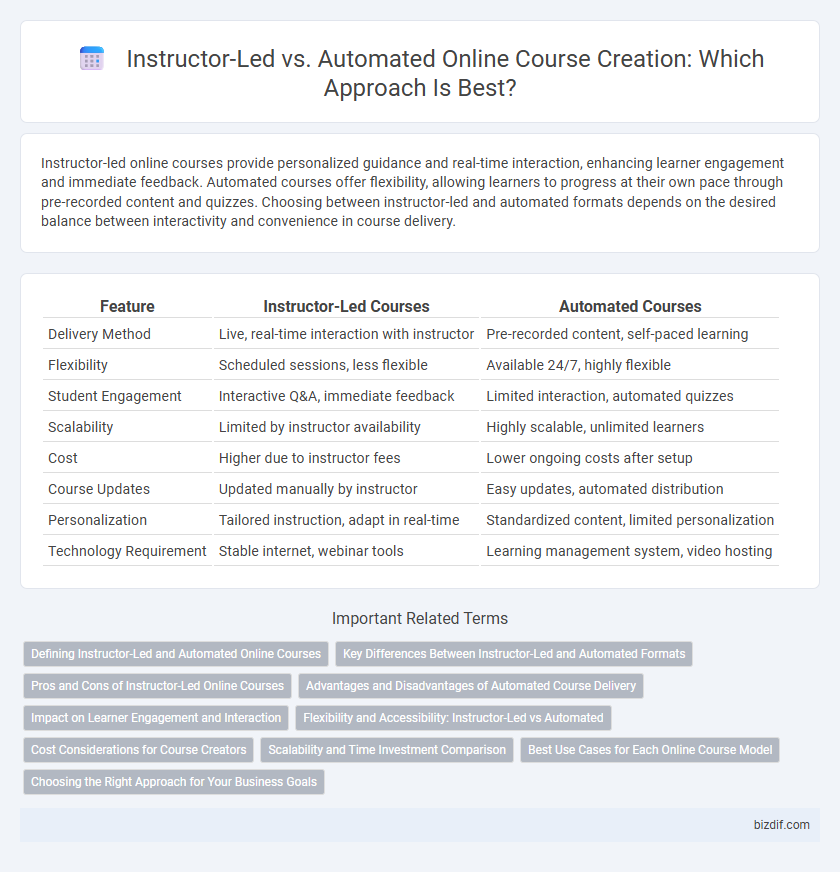Instructor-led online courses provide personalized guidance and real-time interaction, enhancing learner engagement and immediate feedback. Automated courses offer flexibility, allowing learners to progress at their own pace through pre-recorded content and quizzes. Choosing between instructor-led and automated formats depends on the desired balance between interactivity and convenience in course delivery.
Table of Comparison
| Feature | Instructor-Led Courses | Automated Courses |
|---|---|---|
| Delivery Method | Live, real-time interaction with instructor | Pre-recorded content, self-paced learning |
| Flexibility | Scheduled sessions, less flexible | Available 24/7, highly flexible |
| Student Engagement | Interactive Q&A, immediate feedback | Limited interaction, automated quizzes |
| Scalability | Limited by instructor availability | Highly scalable, unlimited learners |
| Cost | Higher due to instructor fees | Lower ongoing costs after setup |
| Course Updates | Updated manually by instructor | Easy updates, automated distribution |
| Personalization | Tailored instruction, adapt in real-time | Standardized content, limited personalization |
| Technology Requirement | Stable internet, webinar tools | Learning management system, video hosting |
Defining Instructor-Led and Automated Online Courses
Instructor-led online courses are guided by live instructors who facilitate real-time interaction, discussions, and personalized feedback, enhancing engagement and comprehension. Automated online courses use pre-recorded content and algorithm-driven assessments, enabling self-paced learning with consistent delivery and scalability. Both formats offer distinct advantages depending on learner preferences and educational goals.
Key Differences Between Instructor-Led and Automated Formats
Instructor-led courses offer real-time interaction, personalized feedback, and dynamic discussions, enhancing learner engagement and adaptability. Automated courses provide flexible, self-paced learning through pre-recorded content and standardized assessments, ensuring scalability and consistent delivery. Key differences lie in immediacy of support, customization potential, and learner autonomy.
Pros and Cons of Instructor-Led Online Courses
Instructor-led online courses offer real-time interaction and immediate feedback, enhancing student engagement and personalized learning experiences. However, they often require rigid scheduling and can be resource-intensive due to the need for live instructors and technical support. This format may also limit scalability, impacting accessibility for larger audiences compared to automated courses.
Advantages and Disadvantages of Automated Course Delivery
Automated course delivery offers consistent content presentation and scalability, allowing instructors to reach a broader audience without real-time involvement. However, it lacks the personalized interaction and immediate feedback that instructor-led courses provide, potentially impacting learner engagement and comprehension. While automation enhances accessibility and efficiency, it may reduce opportunities for dynamic discussion and tailored support essential for complex subjects.
Impact on Learner Engagement and Interaction
Instructor-led online courses foster higher learner engagement and interaction through real-time discussions, personalized feedback, and dynamic Q&A sessions, enhancing motivation and knowledge retention. Automated courses offer scalability and consistent content delivery but often lack the spontaneous interaction that fuels active participation and deeper learning connections. Balancing interactive tools like forums and quizzes in automated courses can partially bridge this gap, yet instructor presence remains crucial for maximizing engagement.
Flexibility and Accessibility: Instructor-Led vs Automated
Instructor-led courses provide real-time interaction and tailored feedback, enhancing learner engagement but often require fixed schedules that limit flexibility. Automated courses offer on-demand access, allowing learners to study anytime and anywhere, maximizing accessibility for diverse time zones and busy lifestyles. Balancing personalized instruction with flexible availability is crucial for optimizing learner outcomes in online education.
Cost Considerations for Course Creators
Instructor-led courses typically require higher upfront costs due to live session scheduling, platform fees, and potentially hiring teaching assistants, making them less scalable but offering personalized interaction. Automated courses involve significant initial investment in content creation and technology but provide cost efficiency over time by eliminating recurring live teaching expenses. Course creators must weigh these cost dynamics against their budget, audience size, and desired level of learner engagement to select the most economically viable delivery method.
Scalability and Time Investment Comparison
Instructor-led courses require significant time investment for live teaching sessions and personalized interaction, limiting scalability to the instructor's availability. Automated courses leverage pre-recorded content and learning management systems, enabling unlimited student enrollment and flexible access without additional time commitments from the instructor. Scalability for automated courses is substantially higher due to reduced need for real-time involvement, allowing creators to reach a global audience efficiently.
Best Use Cases for Each Online Course Model
Instructor-led courses excel in scenarios requiring real-time interaction, personalized feedback, and complex skill development, making them ideal for leadership training and certification programs. Automated courses are best suited for scalable knowledge transfer, standardized content delivery, and flexible learner pacing, which benefits employee onboarding and compliance training. Selecting the right model depends on learner engagement needs, content complexity, and scalability goals.
Choosing the Right Approach for Your Business Goals
Instructor-led courses provide personalized interaction and real-time feedback, ideal for businesses seeking deep engagement and higher completion rates. Automated courses offer scalability and flexibility, reducing costs while reaching a broader audience efficiently. Selecting the right approach depends on your business goals, target audience preferences, and resource availability to balance quality and growth effectively.
Instructor-led vs Automated Infographic

 bizdif.com
bizdif.com